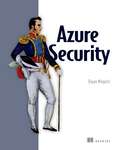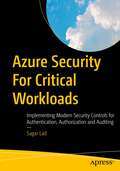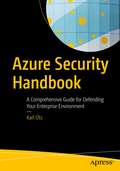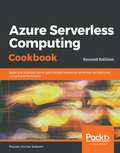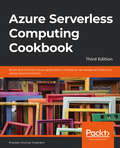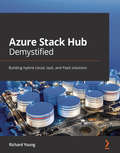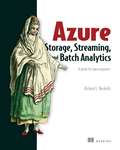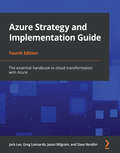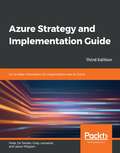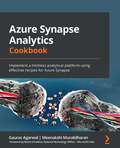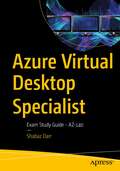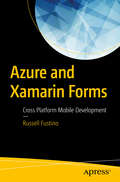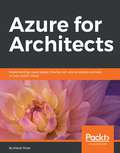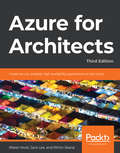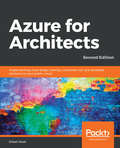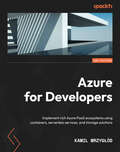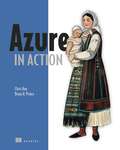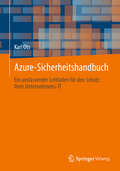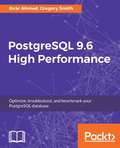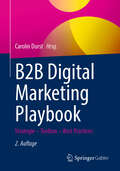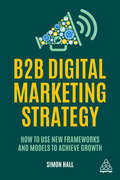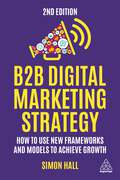- Table View
- List View
Azure Security
by Bojan MagusicSecure your Azure applications the right way. The expert DevSecOps techniques you'll learn in this essential handbook make it easy to keep your data safe.As a Program Manager at Microsoft, Bojan Magusic has helped numerous Fortune 500 companies improve their security posture in Azure. Now, in Azure Security he brings his experience from the cyber security frontline to ensure your Azure cloud-based systems are safe and secure. In Azure Security you&’ll learn vital security skills, including how to: Set up secure access through Conditional Access policiesImplement Azure WAF on Application Gateway and Front Door Deploy Azure Firewall Premium for monitoring network activities Enable Microsoft Defender for Cloud to assess workload configurations Utilize Microsoft Sentinel for threat detection and analytics Establish Azure Policy for compliance with business rules Correctly set up out-of-the-box Azure services to protect your web apps against both common and sophisticated threats, learn to continuously assess your systems for vulnerabilities, and discover cutting-edge operations for security hygiene, monitoring, and DevSecOps. Each stage is made clear and easy to follow with step-by-step instructions, complemented by helpful screenshots and diagrams. About the technology Securing cloud-hosted applications requires a mix of tools, techniques, and platform-specific services. The Azure platform provides built-in security tools to keep your systems safe, but proper implementation requires a foundational strategy and tactical guidance. About the book Azure Security details best practices for configuring and deploying Azure&’s native security services—from a zero-trust foundation to defense in depth (DiD). Learn from a Microsoft security insider how to establish a DevSecOps program using Microsoft Defender for Cloud. Realistic scenarios and hands-on examples help demystify tricky security concepts, while clever exercises help reinforce what you&’ve learned. What's inside Set up secure access policies Implement a Web Application Firewall Deploy MS Sentinel for monitoring and threat detection Establish compliance with business rules About the reader For software and security engineers building and securing Azure applications. About the author Bojan Magusic is a Product Manager with Microsoft on the Security Customer Experience Engineering Team. Table of Contents PART 1 FIRST STEPS 1 About Azure security 2 Securing identities in Azure: The four pillars of identity and Azure Active Directory PART 2 SECURING AZURE RESOURCES 3 Implementing network security in Azure: Firewall, WAF, and DDoS protection 4 Securing compute resources in Azure: Azure Bastion, Kubernetes, and Azure App Service 5 Securing data in Azure Storage accounts: Azure Key Vault 6 Implementing good security hygiene: Microsoft Defender for Cloud and Defender CSPM 7 Security monitoring for Azure resources: Microsoft Defender for Cloud plans PART 3 GOING FURTHER 8 Security operations and response: Microsoft Sentinel 9 Audit and log data: Azure Monitor 10 Importance of governance: Azure Policy and Azure Blueprints 11 DevSecOps: Microsoft Defender for DevOps
Azure Security Cookbook: Practical recipes for securing Azure resources and operations
by Steve MilesGain critical real-world skills to secure your Microsoft Azure infrastructure against cyber attacksPurchase of the print or Kindle book includes a free PDF eBookKey FeaturesDive into practical recipes for implementing security solutions for Microsoft Azure resourcesLearn how to implement Microsoft Defender for Cloud and Microsoft SentinelWork with real-world examples of Azure Platform security capabilities to develop skills quicklyBook DescriptionWith evolving threats, securing your cloud workloads and resources is of utmost importance. Azure Security Cookbook is your comprehensive guide to understanding specific problems related to Azure security and finding the solutions to these problems.This book starts by introducing you to recipes on securing and protecting Azure Active Directory (AD) identities. After learning how to secure and protect Azure networks, you'll explore ways of securing Azure remote access and securing Azure virtual machines, Azure databases, and Azure storage. As you advance, you'll also discover how to secure and protect Azure environments using the Azure Advisor recommendations engine and utilize the Microsoft Defender for Cloud and Microsoft Sentinel tools. Finally, you'll be able to implement traffic analytics; visualize traffic; and identify cyber threats as well as suspicious and malicious activity.By the end of this Azure security book, you will have an arsenal of solutions that will help you secure your Azure workload and resources.What you will learnFind out how to implement Azure security features and toolsUnderstand how to provide actionable insights into security incidentsGain confidence in securing Azure resources and operationsShorten your time to value for applying learned skills in real-world casesFollow best practices and choices based on informed decisionsBetter prepare for Microsoft certification with a security elementWho this book is forThis book is for Azure security professionals, Azure cloud professionals, Azure architects, and security professionals looking to implement secure cloud services using Microsoft Defender for Cloud and other Azure security features. A solid understanding of fundamental security concepts and prior exposure to the Azure cloud will help you understand the key concepts covered in the book more effectively. This book is also beneficial for those aiming to take Microsoft certification exams with a security element or focus.
Azure Security For Critical Workloads: Implementing Modern Security Controls for Authentication, Authorization and Auditing
by Sagar LadThis is a crisp, practical, and hands-on guide to moving mission-critical workloads to Azure. This book focuses on the process and technology aspects of Azure security coupled with pattern-oriented, real-world examples. You will implement modernized security controls, catering to the needs of authentication, authorization, and auditing, thereby protecting the confidentiality and integrity of your infrastructure, applications, and data.The book starts with an introduction to the various dimensions of cloud security, including pattern-based security and Azure's defense security architecture. You will then move on to identity and access management with Azure Active Directory. Here, you will learn the AAD security model, application proxy, and explore AAD B2B and B2C for external partners. Network security patterns and infrastructure security patterns are discussed next, followed by application and data security patterns. Finally, you will learn how to set up security policies and work with Azure Monitor and Azure Sentinel, and to create leadership support and training for a rigorous security culture.After completing this book, you will understand and be able to implement reusable patterns for mission critical workloads, standardizing and expediting the move of those workloads to Azure.What Will You LearnUnderstand security boundaries required to implement Azure's defense-in-depth security architectureUnderstand Azure Active Directory security modelMaster design patterns relating to network, infrastructure, and softwareAutomate security monitoring with advanced observability and gain practical insights on how this can be implemented with Azure Monitor and Azure SentinelWho Is This Book ForDevelopers and IT consultants/architects who are working on Azure.
Azure Security Handbook: A Comprehensive Guide for Defending Your Enterprise Environment
by Karl OtsDid you know that the most common cloud security threats happen because of cloud service misconfigurations, not outside attacks? If you did not, you are not alone. In the on-premises world, cybersecurity risks were limited to the organization’s network, but in the era of cloud computing, both the impact and likelihood of potential risks are significantly higher. With the corresponding advent of DevOps methodology, security is now the responsibility of everyone who is part of the application development life cycle, not just the security specialists. Applying the clear and pragmatic recommendations given in this book, you can reduce the cloud applications security risks in your organization.This is the book that every Azure solution architect, developer, and IT professional should have on hand when they begin their journey learning about Azure security. It demystifies the multitude of security controls and offers numerous guidelines for Azure, curtailing hours of learning fatigue and confusion. Throughout the book you will learn how to secure your applications using Azure’s native security controls. After reading this book, you will know which security guardrails are available, how effective they are, and what will be the cost of implementing them. The scenarios in this book are real and come from securing enterprise applications and infrastructure running on Azure. What You Will Learn Remediate security risks of Azure applications by implementing the right security controls at the right time Achieve a level of security and stay secure across your Azure environment by setting guardrails to automate secure configurationsProtect the most common reference workloads according to security best practicesDesign secure access control solutions for your Azure administrative access, as well as Azure application access Who This Book Is ForCloud security architects, cloud application developers, and cloud solution architects who work with Azure. It is also a valuable resource for those IT professionals responsible for securing Azure workloads in the enterprise.
Azure Serverless Computing Cookbook
by Praveen Kumar SreeramOver 50 recipes to help you build applications hosted on Serverless architecture using Azure Functions. About This Book • Enhance Azure Functions with continuous deployment using Visual Studio Team Services • Learn to deploy and manage cost-effective and highly available serverless applications using Azure Functions • This recipe-based guide will teach you to build a robust serverless environment Who This Book Is For If you are a Cloud administrator, architect, or developer who wants to build scalable systems and deploy serverless applications with Azure functions, then this book is for you. Prior knowledge and hands-on experience with core services of Microsoft Azure is required. What You Will Learn • Develop different event-based handlers supported by serverless architecture supported by Microsoft Cloud Platform – Azure • Integrate Azure Functions with different Azure Services to develop Enterprise-level applications • Get to know the best practices in organizing and refactoring the code within the Azure functions • Test, troubleshoot, and monitor the Azure functions to deliver high-quality, reliable, and robust cloud-centric applications • Automate mundane tasks at various levels right from development to deployment and maintenance • Learn how to develop statefulserverless applications and also self-healing jobs using DurableFunctions In Detail Microsoft provides a solution to easily run small segment of code in the Cloud with Azure Functions. Azure Functions provides solutions for processing data, integrating systems, and building simple APIs and microservices. The book starts with intermediate-level recipes on serverless computing along with some use cases on benefits and key features of Azure Functions. Then, we'll deep dive into the core aspects of Azure Functions such as the services it provides, how you can develop and write Azure functions, and how to monitor and troubleshoot them. Moving on, you'll get practical recipes on integrating DevOps with Azure functions, and providing continuous integration and continous deployment with Visual Studio Team Services. It also provides hands-on steps and tutorials based on real-world serverless use cases, to guide you through configuring and setting up your serverless environments with ease. Finally, you'll see how to manage Azure functions, providing enterprise-level security and compliance to your serverless code architecture. By the end of this book, you will have all the skills required to work with serverless code architecture, providing continuous delivery to your users. Style and approach This recipe-based guide explains the different features of Azure Function by taking a real-world application related to a specific domain. You will learn how to implement automation and DevOps and discover industry best practices to develop applications hosted on serverless architecture using Azure functions.
Azure Serverless Computing Cookbook - Second Edition: Build and monitor Azure applications hosted on serverless architecture using Azure Functions, 2nd Edition
by S Praveen KumarIf you are a cloud administrator, architect, or developer who wants to build scalable systems and deploy serverless applications with Azure functions, then this book is for you. Hands-on experience with core services of Microsoft Azure is required.
Azure Serverless Computing Cookbook: Build and monitor Azure applications hosted on serverless architecture using Azure functions, 3rd Edition
by Praveen Kumar SreeramDiscover recipes for implementing solutions to real-world business problems through serverless applications Key Features Test, troubleshoot, and monitor Azure functions to deliver high-quality and reliable cloud-centric applications Understand Visual Studio's integrated developer experience for Azure functions Explore best practices for organizing and refactoring code within the Azure functions Book Description This third edition of Azure Serverless Computing Cookbook guides you through the development of a basic back-end web API that performs simple operations, helping you understand how to persist data in Azure Storage services. You'll cover the integration of Azure Functions with other cloud services, such as notifications (SendGrid and Twilio), Cognitive Services (computer vision), and Logic Apps, to build simple workflow-based applications. With the help of this book, you'll be able to leverage Visual Studio tools to develop, build, test, and deploy Azure functions quickly. It also covers a variety of tools and methods for testing the functionality of Azure functions locally in the developer's workstation and in the cloud environment. Once you're familiar with the core features, you'll explore advanced concepts such as durable functions, starting with a "hello world" example, and learn about the scalable bulk upload use case, which uses durable function patterns, function chaining, and fan-out/fan-in. By the end of this Azure book, you'll have gained the knowledge and practical experience needed to be able to create and deploy Azure applications on serverless architectures efficiently. What you will learn Implement continuous integration and continuous deployment (CI/CD) of Azure functions Develop different event-based handlers in a serverless architecture Integrate Azure functions with different Azure services to develop enterprise-level applications Accelerate your cloud application development using Azure function triggers and bindings Automate mundane tasks at various levels, from development to deployment and maintenance Develop stateful serverless applications and self-healing jobs using durable functions Who this book is for If you are a cloud developer or architect who wants to build cloud-native systems and deploy serverless applications with Azure functions, this book is for you. Prior experience with Microsoft Azure core services will help you to make the most out of this book.
Azure Stack Hub Demystified: Building hybrid cloud, IaaS, and PaaS solutions
by Richard YoungDeploy, configure, administer, and run Microsoft Azure Stack HubKey FeaturesUnderstand the topics required for the Microsoft Azure AZ-600 examConfigure and provide services from Microsoft Azure Stack HubImplement data center integration with Microsoft Azure Stack HubBook DescriptionAzure Stack Hub is the on-premise offering from Microsoft, which provides Azure Cloud services within a customer's own data center. It provides consistent processes between on-site and the cloud, allowing developers to test locally and deploy to the cloud in exactly the same manner. Azure Stack Hub Demystified provides complete coverage of deploying, configuring, administrating, and running Microsoft Azure Stack Hub efficiently. Firstly, you will learn how to deploy Azure Stack Hub within an organization. As you progress, you'll understand configuration and the different services provided by the platform. The book also focuses on the underlying architecture and connectivity options for the modern data center. Later, you will understand various approaches to DevOps and their implementation, and learn key topics for the AZ-600 exam. By the end of this Azure book, you will have a thorough understanding of Azure Stack Hub and the services that are provided by the platform, along with the confidence and information you need to be able to pass the AZ-600 exam.What you will learnUnderstand the architecture of Azure Stack HubGet up to speed with the management and administration of Azure Stack HubExplore how to administer virtual networking within your Azure StackBecome well versed in using the Azure Stack Hub support model and updating Azure Stack HubUnderstand how licensing and billing is done with Azure Stack HubDiscover the tools that can be used to implement security within Azure Stack HubFocus on how DevOps practices can be incorporated with Azure Stack HubWho this book is forIf you are an Azure Administrator and Azure Stack Hub Operator who provides or is looking to provide cloud services to end users or customers within their own data center, then this book is for you. This book will also be beneficial to those who are preparing for Exam AZ-600: Configuring and Operating a Hybrid Cloud with Microsoft Azure Stack Hub.
Azure Storage, Streaming, and Batch Analytics: A guide for data engineers
by Richard NuckollsThe Microsoft Azure cloud is an ideal platform for data-intensive applications. Designed for productivity, Azure provides pre-built services that make collection, storage, and analysis much easier to implement and manage. Azure Storage, Streaming, and Batch Analytics teaches you how to design a reliable, performant, and cost-effective data infrastructure in Azure by progressively building a complete working analytics system.Summary The Microsoft Azure cloud is an ideal platform for data-intensive applications. Designed for productivity, Azure provides pre-built services that make collection, storage, and analysis much easier to implement and manage. Azure Storage, Streaming, and Batch Analytics teaches you how to design a reliable, performant, and cost-effective data infrastructure in Azure by progressively building a complete working analytics system. Purchase of the print book includes a free eBook in PDF, Kindle, and ePub formats from Manning Publications. About the technology Microsoft Azure provides dozens of services that simplify storing and processing data. These services are secure, reliable, scalable, and cost efficient. About the book Azure Storage, Streaming, and Batch Analytics shows you how to build state-of-the-art data solutions with tools from the Microsoft Azure platform. Read along to construct a cloud-native data warehouse, adding features like real-time data processing. Based on the Lambda architecture for big data, the design uses scalable services such as Event Hubs, Stream Analytics, and SQL databases. Along the way, you&’ll cover most of the topics needed to earn an Azure data engineering certification. What's inside Configuring Azure services for speed and cost Constructing data pipelines with Data Factory Choosing the right data storage methods About the reader For readers familiar with database management. Examples in C# and PowerShell. About the author Richard Nuckolls is a senior developer building big data analytics and reporting systems in Azure. Table of Contents 1 What is data engineering? 2 Building an analytics system in Azure 3 General storage with Azure Storage accounts 4 Azure Data Lake Storage 5 Message handling with Event Hubs 6 Real-time queries with Azure Stream Analytics 7 Batch queries with Azure Data Lake Analytics 8 U-SQL for complex analytics 9 Integrating with Azure Data Lake Analytics 10 Service integration with Azure Data Factory 11 Managed SQL with Azure SQL Database 12 Integrating Data Factory with SQL Database 13 Where to go next
Azure Strategy and Implementation Guide: The essential handbook to cloud transformation with Azure, 4th Edition
by Greg Leonardo Jack Lee Jason Milgram Dave RendonLeverage Azure's cloud capabilities to find the most optimized path to meeting your firm's cloud infrastructure needs.Key FeaturesGet to grips with the core Azure infrastructure technologies and solutionsDevelop the ability to opt for cloud design and architecture that best fits your organizationCover the entire spectrum of cloud migration from planning to implementation and best practicesBook DescriptionMicrosoft Azure is a powerful cloud computing platform that offers a multitude of services and capabilities for organizations of any size moving to a cloud strategy. This fourth edition comes with the latest updates on cloud security fundamentals, hybrid cloud, cloud migration, Microsoft Azure Active Directory, and Windows Virtual Desktop. It encapsulates the entire spectrum of measures involved in Azure deployment that includes understanding Azure fundamentals, choosing a suitable cloud architecture, building on design principles, becoming familiar with Azure DevOps, and learning best practices for optimization and management. The book begins by introducing you to the Azure cloud platform and demonstrating the substantial scope of digital transformation and innovation that can be achieved with Azure's capabilities. The guide also acquaints you with practical insights into application modernization, Azure Infrastructure as a Service (IaaS) deployment, infrastructure management, key application architectures, best practices of Azure DevOps, and Azure automation. By the end of this book, you will have acquired the skills required to drive Azure operations from the planning and cloud migration stage to cost management and troubleshooting. What you will learnUnderstand core Azure infrastructure technologies and solutionsCarry out detailed planning for migrating applications to the cloud with AzureDeploy and run Azure infrastructure servicesDefine roles and responsibilities in DevOpsGet a firm grip on Azure security fundamentalsCarry out cost optimization in AzureWho this book is forThis book is designed to benefit Azure architects, cloud solution architects, Azure developers, Azure administrators, and anyone who wants to develop expertise in operating and administering the Azure cloud. Basic familiarity with operating systems and databases will help you grasp the concepts covered in this book.
Azure Strategy and Implementation Guide: Up-to-date information for organizations new to Azure, 3rd Edition
by Peter De Tender Greg Leonardo Jason MilgramLearn Azure's cloud capabilities with the help of this introductory guide to employing Azure for your cloud infrastructure needs. Key Features Get a clear overview of Azure's capabilities and benefits, and learn how to get started efficiently Develop the ability to opt for cloud architecture and design that best fits your organization Leverage Azure opportunities for cost savings and optimization Book Description Microsoft Azure is a powerful cloud computing platform that offers a multitude of services and capabilities for organizations of any size moving to a cloud strategy. Azure Strategy and Implementation Guide Third Edition encapsulates the entire spectrum of measures involved in Azure deployment that includes understanding Azure fundamentals, choosing a suitable cloud architecture, building on design principles, becoming familiar with Azure DevOps, and learning best practices for optimization and management. The book begins by introducing you to the Azure cloud platform and demonstrating the substantial scope of digital transformation and innovation that can be achieved by leveraging Azure's capabilities. The guide further acquaints you with practical insights on application modernization, Azure Infrastructure as a Service (IaaS) deployment, infrastructure management, key application architectures, best practices of Azure DevOps, and Azure automation. By the end of this book, you will be proficient in driving Azure operations right from the planning and cloud migration stage to cost management and troubleshooting. What you will learn Deploy and run Azure infrastructure services Carry out detailed planning for migrating applications to the cloud with Azure Move underlying code class structure into a serverless model Use a gateway to isolate your services and applications Define roles and responsibilities in DevOps Implement release & deployment coordination and automation Who this book is for Azure Strategy and Implementation Guide Third Edition is designed to benefit Azure architects, cloud solution architects, Azure developers, Azure administrators, and anyone who wants to develop an expertise in operating and administering the Azure cloud. A basic familiarity with operating systems and databases will help you grasp the concepts covered in this book.
Azure Synapse Analytics Cookbook: Implement a limitless analytical platform using effective recipes for Azure Synapse
by Gaurav Agarwal Meenakshi Muralidharan Rohini SrivathsaWhether you're an Azure veteran or just getting started, get the most out of your data with effective recipes for Azure SynapseKey FeaturesDiscover new techniques for using Azure Synapse, regardless of your level of expertiseIntegrate Azure Synapse with other data sources to create a unified experience for your analytical needs using Microsoft AzureLearn how to embed data governance and classification with Synapse Analytics by integrating Azure PurviewBook DescriptionAs data warehouse management becomes increasingly integral to successful organizations, choosing and running the right solution is more important than ever. Microsoft Azure Synapse is an enterprise-grade, cloud-based data warehousing platform, and this book holds the key to using Synapse to its full potential. If you want the skills and confidence to create a robust enterprise analytical platform, this cookbook is a great place to start. You'll learn and execute enterprise-level deployments on medium-to-large data platforms. Using the step-by-step recipes and accompanying theory covered in this book, you'll understand how to integrate various services with Synapse to make it a robust solution for all your data needs. Whether you're new to Azure Synapse or just getting started, you'll find the instructions you need to solve any problem you may face, including using Azure services for data visualization as well as for artificial intelligence (AI) and machine learning (ML) solutions. By the end of this Azure book, you'll have the skills you need to implement an enterprise-grade analytical platform, enabling your organization to explore and manage heterogeneous data workloads and employ various data integration services to solve real-time industry problems.What you will learnDiscover the optimal approach for loading and managing dataWork with notebooks for various tasks, including MLRun real-time analytics using Azure Synapse Link for Cosmos DBPerform exploratory data analytics using Apache SparkRead and write DataFrames into Parquet files using PySparkCreate reports on various metrics for monitoring key KPIsCombine Power BI and Serverless for distributed analysisEnhance your Synapse analysis with data visualizationsWho this book is forThis book is for data architects, data engineers, and developers who want to learn and understand the main concepts of Azure Synapse analytics and implement them in real-world scenarios.
Azure Virtual Desktop Specialist: Exam Study Guide - AZ-140
by Shabaz DarrEnhance your knowledge and become certified with the Azure Virtual Desktop technology. This book provides the theory, lab exercises, and knowledge checks you need to prepare for the AZ-140 exam. The book starts with an introduction to Azure Virtual Desktop and AZ-140 exam objectives. You will learn the architecture behind Azure Virtual Desktop, including compute, identity, and storage. And you will learn how to implement all of the services that make up the Azure Virtual Desktop platform. Each chapter includes exam and practice questions. The book takes you through the access and security of Azure Virtual Desktop along with its user environment and application. And it teaches you how to monitor and maintain an Azure Virtual Desktop infrastructure. After reading this book, you will be prepared to take the AZ-140 exam.What You Will LearnPlan an Azure Virtual Desktop architectureInstall and configure apps on a session hostPlan and implement business continuity and disaster recoveryUnderstand user environment and applications in Azure Virtual DesktopWho This Book Is ForAzure administrators who wish to increase their knowledge and become certified with the Azure Virtual Desktop technology
Azure and Xamarin Forms: Cross Platform Mobile Development
by Russell FustinoDiscover how to create cross platform apps for Android, iOS and UWP using Azure services and C# with Xamarin Forms. This book illustrates how to utilize Azure cloud storage for serving up Azure SQL DB data through Azure App Services.The book starts by setting up Xamarin and introducing Xamarin Forms and then covers the Azure Portal from a developer’s perspective and goes on to demonstrate how to build an Azure Service using Quickstart. You'll also see how to add Azure support to Xamarin Forms application. You'll review in detail how to build a Xamarin Form with Azure Client and modify an existing app to become a Xamarin Forms Client for Azure with offline synchronization.You then move on to third-party controls that speed up development. By the end of the book, you will be able to use Azure and Xamarin together and master how to use Azure Mobile Quickstarts, Azure SQL plumbing, database synchronization and Xamarin Forms.What You'll LearnCreate a Xamarin Forms App and understand the Structure of a Xamarin Forms App. Navigate pages and use platform specific coding. Use images, ListView and the Azure Mobile App Quickstart to build a Service and Xamarin Forms appModify an existing app to use Azure Client Libraries, understand offline storage with SQLite and incorporate offline synchronizationWho This Book Is For Software developers new to Xamarin and/or Azure and for the developers who are familiar with both the technologies to use in mobile apps.
Azure for Architects: Create Secure, Scalable, High-availability Applications On The Cloud, 3rd Edition
by Ritesh ModiIf you are Cloud Architects, DevOps Engineers, or developers who want to learn key architectural aspects of the Azure Cloud platform, then this book is for you. Prior basic knowledge of the Azure Cloud platform is good to have.
Azure for Architects: Create secure, scalable, high-availability applications on the cloud, 3rd Edition
by Ritesh Modi Jack Lee Rithin SkariaBuild and design multiple types of applications that are cross-language, platform, and cost-effective by understanding core Azure principles and foundational concepts Key Features Get familiar with the different design patterns available in Microsoft Azure Develop Azure cloud architecture and a pipeline management system Get to know the security best practices for your Azure deployment Book Description Thanks to its support for high availability, scalability, security, performance, and disaster recovery, Azure has been widely adopted to create and deploy different types of application with ease. Updated for the latest developments, this third edition of Azure for Architects helps you get to grips with the core concepts of designing serverless architecture, including containers, Kubernetes deployments, and big data solutions. You'll learn how to architect solutions such as serverless functions, you'll discover deployment patterns for containers and Kubernetes, and you'll explore large-scale big data processing using Spark and Databricks. As you advance, you'll implement DevOps using Azure DevOps, work with intelligent solutions using Azure Cognitive Services, and integrate security, high availability, and scalability into each solution. Finally, you'll delve into Azure security concepts such as OAuth, OpenConnect, and managed identities. By the end of this book, you'll have gained the confidence to design intelligent Azure solutions based on containers and serverless functions. What you will learn Understand the components of the Azure cloud platform Use cloud design patterns Use enterprise security guidelines for your Azure deployment Design and implement serverless and integration solutions Build efficient data solutions on Azure Understand container services on Azure Who this book is for If you are a cloud architect, DevOps engineer, or a developer looking to learn about the key architectural aspects of the Azure cloud platform, this book is for you. A basic understanding of the Azure cloud platform will help you grasp the concepts covered in this book more effectively.
Azure for Architects: Implementing cloud design, DevOps, containers, IoT, and serverless solutions on your public cloud, 2nd Edition
by Ritesh ModiCreate advanced data and integrated solutions using Azure Event Grid, functions, and containers Key Features Get familiar with the different design patterns available in Microsoft Azure Develop Azure cloud architecture and a pipeline management system Get to know the security best practices for your Azure deployment Book Description Over the years, Azure cloud services have grown quickly, and the number of organizations adopting Azure for their cloud services is also gradually increasing. Leading industry giants are finding that Azure fulfills their extensive cloud requirements. Azure for Architects – Second Edition starts with an extensive introduction to major designing and architectural aspects available with Azure. These design patterns focus on different aspects of the cloud, such as high availability, security, and scalability. Gradually, we move on to other aspects, such as ARM template modular design and deployments. This is the age of microservices and serverless is the preferred implementation mechanism for them. This book covers the entire serverless stack available in Azure including Azure Event Grid, Azure Functions, and Azure Logic Apps. New and advance features like durable functions are discussed at length. A complete integration solution using these serverless technologies is also part of the book. A complete chapter discusses all possible options related to containers in Azure including Azure Kubernetes services, Azure Container Instances and Registry, and Web App for Containers. Data management and integration is an integral part of this book that discusses options for implementing OLTP solutions using Azure SQL, Big Data solutions using Azure Data factory and Data Lake Storage, eventing solutions using stream analytics, and Event Hubs. This book will provide insights into Azure governance features such as tagging, RBAC, cost management, and policies. By the end of this book, you will be able to develop a full-?edged Azure cloud solution that is Enterprise class and future-ready. What you will learn Create an end-to-end integration solution using Azure Serverless Stack Learn Big Data solutions and OLTP–based applications on Azure Understand DevOps implementations using Azure DevOps Architect solutions comprised of multiple resources in Azure Develop modular ARM templates Develop Governance on Azure using locks, RBAC, policies, tags and cost Learn ways to build data solutions on Azure Understand the various options related to containers including Azure Kubernetes Services Who this book is for If you are Cloud Architects, DevOps Engineers, or developers who want to learn key architectural aspects of the Azure Cloud platform, then this book is for you. Prior basic knowledge of the Azure Cloud platform is good to have.
Azure for Developers: Implement rich Azure PaaS ecosystems using containers, serverless services, and storage solutions
by Kamil MrzygłódDevelop cloud applications based on the most popular Azure services, including hosting web applications, running containers, storing data using both relational and non-relational databases, and much moreKey FeaturesTake a modern approach to Azure Cloud development and managementGet a detailed introduction to services such as web hosting, databases, and serverless platformsGet the hang of cloud services with this practical, developer-centric guide for Azure developersBook DescriptionMicrosoft Azure is currently one of the fastest growing public cloud service providers thanks to its sophisticated set of services for building fault-tolerant and scalable cloud-based applications. This second edition of Azure for Developers will take you on a journey through the various PaaS services available in Azure, including Azure App Service, Azure Functions, and Azure SQL Databases, showing you how to build a complete and reliable system with ease. Throughout the book, you’ll discover ways to enhance your skills when building cloud-based solutions leveraging different SQL/NoSQL databases, serverless and messaging components, containerized solutions, and even search engines such as Azure Cognitive Search. That’s not all!! The book also covers more advanced scenarios such as scalability best practices, serving static content with Azure CDN, and distributing loads with Azure Traffic Manager, Azure Application Gateway, and Azure Front Door. By the end of this Azure book, you’ll be able to build modern applications on the Azure cloud using the most popular and promising technologies to make your solutions reliable, stable, and efficient.What you will learnIdentify the Azure services that can help you get the results you needImplement PaaS components – Azure App Service, Azure SQL, Traffic Manager, CDN, Notification Hubs, and Azure Cognitive SearchWork with serverless componentsIntegrate applications with storagePut together messaging components (Event Hubs, Service Bus, and Azure Queue Storage)Use Application Insights to create complete monitoring solutionsSecure solutions using Azure RBAC and manage identitiesDevelop fast and scalable cloud applicationsWho this book is forThis book is for developers and IT professionals who want to learn Microsoft Azure by developing applications based on various cloud services. Prior knowledge of software development and the basics of software architecture and Azure services give you an advantage.
Azure for Developers: Implement rich Azure PaaS ecosystems using containers, serverless services, and storage solutions, 2nd Edition
by Kamil MrzyglodDevelop cloud applications based on the most popular Azure services, including hosting web applications, running containers, storing data using both relational and non-relational databases, and much moreKey FeaturesTake a modern approach to Azure Cloud development and managementGet a detailed introduction to services such as web hosting, databases, and serverless platformsGet the hang of cloud services with this practical, developer-centric guide for Azure developersBook DescriptionMicrosoft Azure is currently one of the fastest growing public cloud service providers thanks to its sophisticated set of services for building fault-tolerant and scalable cloud-based applications.This second edition of Azure for Developers will take you on a journey through the various PaaS services available in Azure, including Azure App Service, Azure Functions, and Azure SQL Databases, showing you how to build a complete and reliable system with ease. Throughout the book, you'll discover ways to enhance your skills when building cloud-based solutions leveraging different SQL/NoSQL databases, serverless and messaging components, containerized solutions, and even search engines such as Azure Cognitive Search. That's not all!! The book also covers more advanced scenarios such as scalability best practices, serving static content with Azure CDN, and distributing loads with Azure Traffic Manager, Azure Application Gateway, and Azure Front Door.By the end of this Azure book, you'll be able to build modern applications on the Azure cloud using the most popular and promising technologies to make your solutions reliable, stable, and efficient.What you will learnIdentify the Azure services that can help you get the results you needImplement PaaS components – Azure App Service, Azure SQL, Traffic Manager, CDN, Notification Hubs, and Azure Cognitive SearchWork with serverless componentsIntegrate applications with storagePut together messaging components (Event Hubs, Service Bus, and Azure Queue Storage)Use Application Insights to create complete monitoring solutionsSecure solutions using Azure RBAC and manage identitiesDevelop fast and scalable cloud applicationsWho this book is forThis book is for developers and IT professionals who want to learn Microsoft Azure by developing applications based on various cloud services. Prior knowledge of software development and the basics of software architecture and Azure services give you an advantage.
Azure in Action
by Chris Hay Brian PrinceAzure in Action is a fast-paced tutorial intended for architects and developers looking to develop cloud-based applications on the Windows Azure Platform. Written by two of Microsoft's leading Azure evangelists, it's designed both for readers new to cloud concepts and for those familiar with cloud development but new to Azure.Starting with core concepts, the book explores designing and scaling front-end and back-end services that run in the cloud, and more advanced scenarios in Windows Azure. Later chapters introduce the rest of the Azure Services Platform with a particular focus on SQL Azure Database.
Azure-Sicherheitshandbuch: Ein umfassender Leitfaden für den Schutz Ihrer Unternehmens-IT
by Karl OtsWussten Sie, dass die häufigsten Cloud-Sicherheitsbedrohungen auf Fehlkonfigurationen von Cloud-Diensten und nicht auf Angriffe von außen zurückzuführen sind? Wenn Sie das nicht wussten, sind Sie nicht allein. In der lokalen Welt waren die Cybersicherheitsrisiken auf das Netzwerk des Unternehmens beschränkt, aber im Zeitalter des Cloud Computing sind sowohl die Auswirkungen als auch die Wahrscheinlichkeit potenzieller Risiken deutlich höher. Mit dem Aufkommen der DevOps-Methodik liegt die Verantwortung für die Sicherheit nun bei allen, die am Lebenszyklus der Anwendungsentwicklung beteiligt sind, und nicht nur bei den Sicherheitsspezialisten. Durch die Anwendung der klaren und pragmatischen Empfehlungen in diesem Buch können Sie die Sicherheitsrisiken von Cloud-Anwendungen in Ihrem Unternehmen reduzieren. Dies ist das Buch, das jeder Azure-Lösungsarchitekt, Entwickler und IT-Fachmann zur Hand haben sollte, wenn er mit dem Lernen über Azure-Sicherheit beginnt. Es entmystifiziert die Vielzahl von Sicherheitskontrollen und bietet zahlreiche Richtlinien für Azure, wodurch stundenlange Lernmüdigkeit und Verwirrung vermieden werden. Im Laufe des Buches lernen Sie, wie Sie Ihre Anwendungen mit den nativen Sicherheitskontrollen von Azure schützen können. Nach der Lektüre dieses Buches wissen Sie, welche Sicherheitsleitplanken zur Verfügung stehen, wie effektiv sie sind und wie hoch die Kosten für ihre Implementierung sein werden. Die Szenarien in diesem Buch sind real und stammen aus der Sicherung von Unternehmensanwendungen und Infrastrukturen, die auf Azure laufen. Was Sie lernen werden Behebung der Sicherheitsrisiken von Azure-Anwendungen durch Implementierung der richtigen Sicherheitskontrollen zur richtigen Zeit Erreichen Sie ein Sicherheitsniveau und bleiben Sie in Ihrer Azure-Umgebung sicher, indem Sie Leitplanken zur Automatisierung sicherer Konfigurationen festlegen. Schutz der gängigsten Referenz-Workloads gemäß bewährter Sicherheitsverfahren Entwerfen Sie sichere Zugangskontrolllösungen für Ihren administrativen Azure-Zugang sowie für den Zugang zu Azure-Anwendungen Für wen dieses Buch bestimmt ist Cloud-Sicherheitsarchitekten, Cloud-Anwendungsentwickler und Cloud-Lösungsarchitekten, die mit Azure arbeiten. Es ist auch eine wertvolle Ressource für IT-Experten, die für die Sicherung von Azure-Workloads im Unternehmen verantwortlich sind.
B03602_PostgreSQL High Performance
by Packt Publishing<P><P>Enhance the performance of your PostgreSQL system with this handy guide while avoiding common pitfalls that can slow it down. <P><P>Key Features <P><P>Learn the right techniques to obtain optimal PostgreSQL database performance, ranging from initial design to routine maintenance <P><P>Fine tune the performance of your queries and avoid the common pitfalls that can slow your system down <P><P>Contains tips and tricks on scaling successful database installations, and ensuring a highly available PostgreSQL solution <P><P>Book Description <P><P>Database administrators and developers spend years learning techniques to configure their PostgreSQL database servers for optimal performance, mostly when they encounter performance issues. Scalability and high availability of the database solution is equally important these days. This book will show you how to configure new database installations and optimize existing database server installations using PostgreSQL 9.6. <P><P>You will start with the basic concepts of database performance, because all successful database applications are destined to eventually run into issues when scaling up their performance. You will not only learn to optimize your database and queries for optimal performance, but also detect the real performance bottlenecks using PostgreSQL tools and some external tools. Next, you will learn how to benchmark your hardware and tune your operating system. Optimize your queries against the database with the help of right indexes, and monitor every layer, ranging from hardware to queries. Moving on, you will see how connection pooling, caching, partitioning, and replication will help you handle increasing database workloads. <P><P>Achieving high database performance is not easy, but you can learn it by using the right guide-PostgreSQL 9.6 High Performance. <P><P>What you will learn <P><P>Learn the best practices to configure your PostgreSQL 9.6 database for optimal performance <P><P>Write optimal queries and techniques to detect performance issue in queries <P><P>Fine tune the performance of your queries using benchmarking and indexing techniques <P><P>Ensure high performance and a highly available database using the scaling and replication techniques <P><P>Discover how to make informed speed and reliability trade-offs Handle increasing database workloads without any hassle <P><P>Use monitoring insights to continuously rework the design and configuration for best performance
B2B Digital Marketing Playbook: Strategie – Toolbox – Best Practices
by Carolin DurstMit diesem Buch hältst Du den Kompass für das moderne B2B-Marketing im digitalen Zeitalter in der Hand. Von der Marketingstrategie über Kanäle und Tools findest Du alles, was Du als CMO oder Marketingexperte in einem mittelständischen B2B-Unternehmen benötigst. Wir geben Dir Werkzeuge an die Hand, Silos aufzubrechen und abteilungsübergreifend eine wirksame Kommunikation aufzusetzen, die mehr leistet als nur kurzfristig Leads zu produzieren. Unser Playbook ist dabei hands-on und voller Best Practices, Checklisten und Erfahrungsberichten. Das B2B Digital Marketing Playbook ist nichts, was Du von vorne bis hinten durchackern musst. Benutze es wie ein Handbuch: Immer dann, wenn eine Frage oder ein Thema im Job auftaucht – nachschlagen, lesen, umsetzen. Ein Buch aus der Praxis für die Praxis – ein Buch für B2B-Marketers, die Ihre Marketing-Performance für alle sichtbar steigern wollen. Diese zweite Auflage wurde vollständig aktualisiert und erweitert. Aus dem Inhalt: Strategie – Toolbox – Operatives Marketing Wie Du Dein Unternehmen positionierst und kluge Marketingziele formulierst Wie Du ein funktionierendes Marketing-KPI-System aufbaust Wie Du die wichtigsten Digital-Marketing-Instrumente effizient einsetzt: von Websites und E-Mail- sowie Video-Marketing über Corporate Influencer bis zu Podcasts und hybriden Events Wie Du einen passenden Marketing-Technologie-Stack auswählst Wie Du ein starkes Marketing-Team aufbaust Wie aus den ewigen Widersachern Marketing und Vertrieb ein Dreamteam wird Was die Geschäftsführung erwartet und wie Du deren Vertrauen gewinnst
B2B Digital Marketing Strategy: How to Use New Frameworks and Models to Achieve Growth
by Simon HallB2B Digital Marketing Strategy is a decisive guide to the most recent developments in the field. It gives readers an overview of the latest frameworks and models, and shows how these can be used to overcome the everyday challenges associated with account targeting, data utilization, and digital campaign management.Intensely practical, B2B Digital Marketing Strategy helps readers get to grips with some of the more advanced and complex elements of B2B marketing. It expertly explains how to incorporate the latest digital methodologies into critical processes such as lead generation, customer retention and customer experience personalization. Packed with global case studies and examples, this book is an invaluable resource for any professional operating in the B2B space.
B2B Digital Marketing Strategy: How to Use New Frameworks and Models to Achieve Growth
by Simon HallHone and perfect your digital marketing skills and learn how to apply them effectively to B2B marketing with the new edition of this bestselling guide. B2B Digital Marketing Strategy is a clear and practical digital marketing guide that helps readers get to grips with some of the more advanced and complex elements of B2B marketing. It gives readers an overview of the latest approaches, models, processes and solutions, as well as examples of technologies to help them deal with key current B2B digital marketing challenges such as those associated with account targeting, data utilization and digital campaign management. It expertly explains how to incorporate the latest digital methodologies into critical processes such as lead generation, customer retention and customer experience personalization. This book is an invaluable resource for any professional or student in the B2B space. Newly updated, this second edition provides two new chapters on digital retention marketing and social media strategies as well as improved guidance on campaign tracking and gamification. This practical guide is packed with global case studies and examples such as Danfoss, American Express and IBM.
